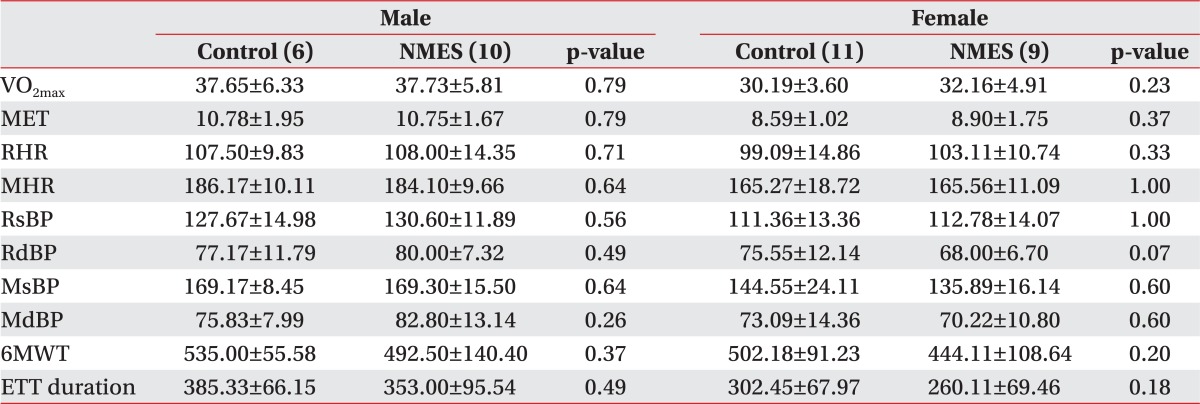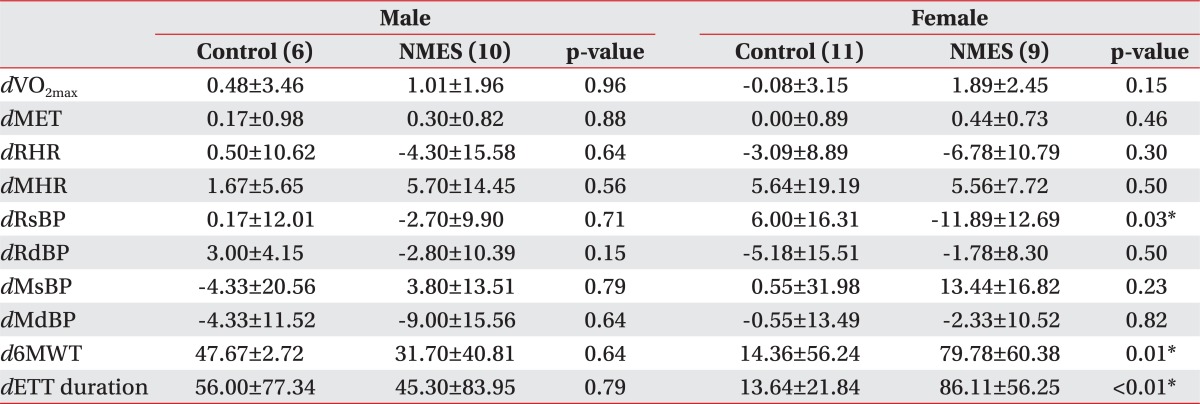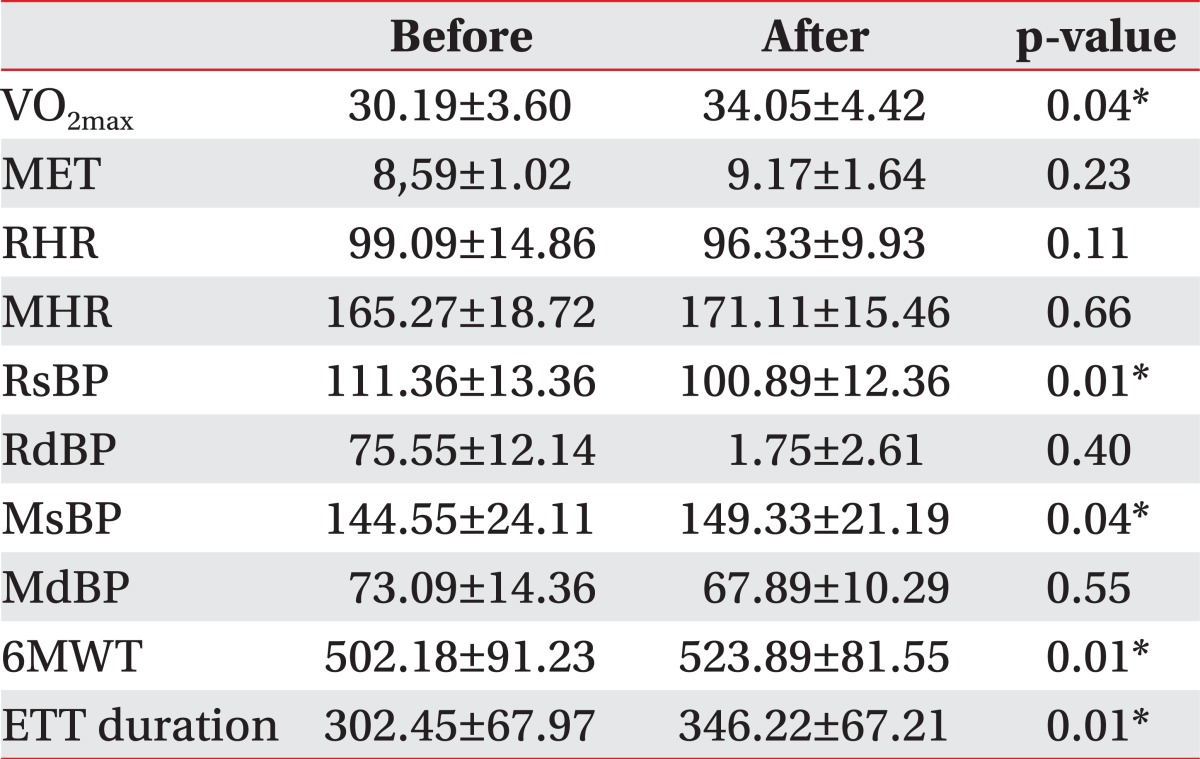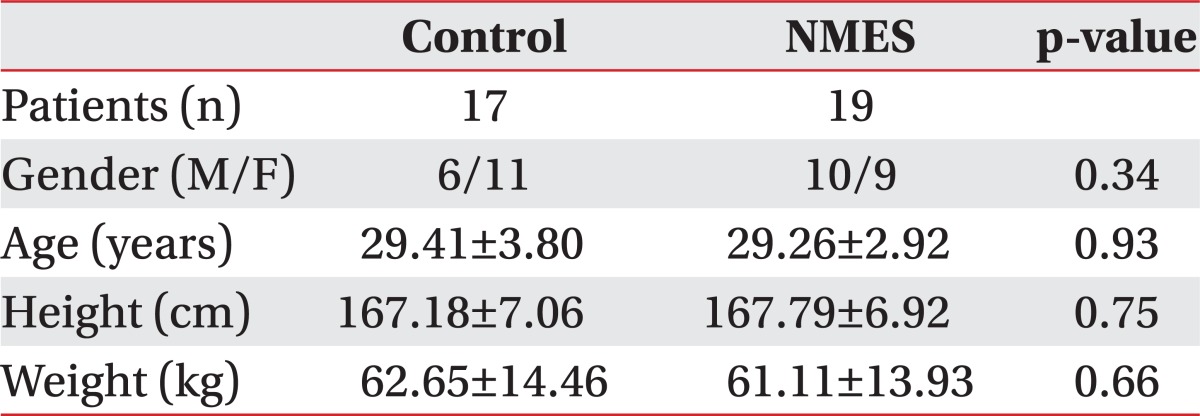1. Statistic Korea. Annual report on the cause of death statistics. 2011. 1st ed. Daejeon: Kangmoon;p. 1–300.
2. O'Connor GT, Buring JE, Yusuf S, Goldhaber SZ, Olmstead EM, Paffenbarger RS Jr, Hennekens CH. An overview of randomized trials of rehabilitation with exercise after myocardial infarction. Circulation. 1989; 80:234–244. PMID:
2665973.
3. Taylor RS, Brown A, Ebrahim S, Jolliffe J, Noorani H, Rees K, Skidmore B, Stone JA, Thompson DR, Oldridge N. Exercise-based rehabilitation for patients with coronary heart disease: systematic review and meta-analysis of randomized controlled trials. Am J Med. 2004; 116:682–692. PMID:
15121495.

4. Karapolat H, Durmaz B. Exercise in cardiac rehabilitation. Anadolu Kardiyol Derg. 2008; 8:51–57. PMID:
18258535.
5. Kim C, Youn JE, Choi HE. The effect of a self exercise program in cardiac rehabilitation for patients with coronary artery disease. Ann Rehabil Med. 2011; 35:381–387. PMID:
22506148.

6. Kim C, Bang IK, Jung IT, Kim YJ, Park YK. The causes for the premature termination of graded exercise test in a cardiac rehabilitation setting. J Korean Acad Rehabil Med. 2007; 31:109–112.
7. Krum H. The Task Force for the diagnosis and treatment of chronic heart failure of the European Society of Cardiology. Guidelines for the diagnosis and treatment of chronic heart failure: full text (update 2005). Eur Heart J. 2005; 26:2472–2474. PMID:
16204262.

8. Sillen MJ, Janssen PP, Akkermans MA, Wouters EF, Spruit MA. The metabolic response during resistance training and neuromuscular electrical stimulation (NMES) in patients with COPD, a pilot study. Respir Med. 2008; 102:786–789. PMID:
18294832.

9. Sillen MJ, Speksnijder CM, Eterman RM, Janssen PP, Wagers SS, Wouters EF, Uszko-Lencer NH, Spruit MA. Effects of neuromuscular electrical stimulation of muscles of ambulation in patients with chronic heart failure or COPD: a systematic review of the English-language literature. Chest. 2009; 136:44–61. PMID:
19363213.
10. Santos M, Zahner LH, McKiernan BJ, Mahnken JD, Quaney B. Neuromuscular electrical stimulation improves severe hand dysfunction for individuals with chronic stroke: a pilot study. J Neurol Phys Ther. 2006; 30:175–183. PMID:
17233925.
11. Kesar TM, Perumal R, Jancosko A, Reisman DS, Rudolph KS, Higginson JS, Binder-Macleod SA. Novel patterns of functional electrical stimulation have an immediate effect on dorsiflexor muscle function during gait for people poststroke. Phys Ther. 2010; 90:55–66. PMID:
19926681.

12. Sheffler LR, Chae J. Neuromuscular electrical stimulation in neurorehabilitation. Muscle Nerve. 2007; 35:562–590. PMID:
17299744.

13. Kim YM, Chun MH, Kang SH, Ahn WH. The effect of neuromuscular electrical stimulation on trunk control in hemiparetic stroke patients. J Korean Acad Rehabil Med. 2009; 33:265–270.
14. Vaquero AF, Chicharro JL, Gil L, Ruiz MP, Sanchez V, Lucia A, Urrea S, Gomez MA. Effects of muscle electrical stimulation on peak VO2 in cardiac transplant patients. Int J Sports Med. 1998; 19:317–322. PMID:
9721054.
15. Quittan M, Wiesinger GF, Sturm B, Puig S, Mayr W, Sochor A, Paternostro T, Resch KL, Pacher R, Fialka-Moser V. Improvement of thigh muscles by neuromuscular electrical stimulation in patients with refractory heart failure: a single-blind, randomized, controlled trial. Am J Phys Med Rehabil. 2001; 80:206–214. PMID:
11237275.
16. Karavidas AI, Raisakis KG, Parissis JT, Tsekoura DK, Adamopoulos S, Korres DA, Farmakis D, Zacharoulis A, Fotiadis I, Matsakas E, et al. Functional electrical stimulation improves endothelial function and reduces peripheral immune responses in patients with chronic heart failure. Eur J Cardiovasc Prev Rehabil. 2006; 13:592–597. PMID:
16874150.

17. Harris S, LeMaitre JP, Mackenzie G, Fox KA, Denvir MA. A randomised study of home-based electrical stimulation of the legs and conventional bicycle exercise training for patients with chronic heart failure. Eur Heart J. 2003; 24:871–878. PMID:
12727155.

18. Dobsak P, Novakova M, Fiser B, Siegelova J, Balcarkova P, Spinarova L, Vitovec J, Minami N, Nagasaka M, Kohzuki M, et al. Electrical stimulation of skeletal muscles. An alternative to aerobic exercise training in patients with chronic heart failure? Int Heart J. 2006; 47:441–453. PMID:
16823250.
19. Neder JA, Sword D, Ward SA, Mackay E, Cochrane LM, Clark CJ. Home based neuromuscular electrical stimulation as a new rehabilitative strategy for severely disabled patients with chronic obstructive pulmonary disease (COPD). Thorax. 2002; 57:333–337. PMID:
11923552.

20. Vivodtzev I, Pepin JL, Vottero G, Mayer V, Porsin B, Levy P, Wuyam B. Improvement in quadriceps strength and dyspnea in daily tasks after 1 month of electrical stimulation in severely deconditioned and malnourished COPD. Chest. 2006; 129:1540–1548. PMID:
16778272.

21. Figoni SF. Exercise responses and quadriplegia. Med Sci Sports Exerc. 1993; 25:433–441. PMID:
8479297.
22. Nuhr MJ, Pette D, Berger R, Quittan M, Crevenna R, Huelsman M, Wiesinger GF, Moser P, Fialka-Moser V, Pacher R. Beneficial effects of chronic low-frequency stimulation of thigh muscles in patients with advanced chronic heart failure. Eur Heart J. 2004; 25:136–143. PMID:
14720530.
23. Deley G, Kervio G, Verges B, Hannequin A, Petitdant MF, Salmi-Belmihoub S, Grassi B, Casillas JM. Comparison of low-frequency electrical myostimulation and conventional aerobic exercise training in patients with chronic heart failure. Eur J Cardiovasc Prev Rehabil. 2005; 12:226–233. PMID:
15942420.

24. Banerjee P, Clark A, Witte K, Crowe L, Caulfield B. Electrical stimulation of unloaded muscles causes cardiovascular exercise by increasing oxygen demand. Eur J Cardiovasc Prev Rehabil. 2005; 12:503–508. PMID:
16210939.

25. Hsu MJ, Wei SH, Chang YJ. Effect of neuromuscular electrical muscle stimulation on energy expenditure in healthy adults. Sensors (Basel). 2011; 11:1932–1942. PMID:
22319390.









 PDF
PDF ePub
ePub Citation
Citation Print
Print




 XML Download
XML Download